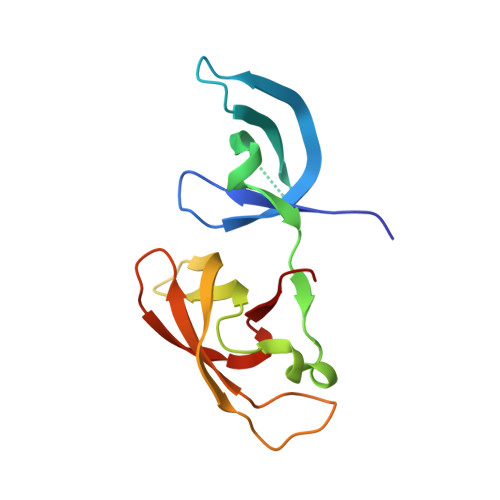Polymerase IV occupancy at RNA-directed DNA methylation sites requires SHH1.
Law, J.A., Du, J., Hale, C.J., Feng, S., Krajewski, K., Palanca, A.M., Strahl, B.D., Patel, D.J., Jacobsen, S.E.(2013) Nature 498: 385-389
- PubMed: 23636332
- DOI: https://doi.org/10.1038/nature12178
- Primary Citation of Related Structures:
4IUP, 4IUQ, 4IUR, 4IUT, 4IUU, 4IUV - PubMed Abstract:
DNA methylation is an epigenetic modification that has critical roles in gene silencing, development and genome integrity. In Arabidopsis, DNA methylation is established by DOMAINS REARRANGED METHYLTRANSFERASE 2 (DRM2) and targeted by 24-nucleotide small interfering RNAs (siRNAs) through a pathway termed RNA-directed DNA methylation (RdDM). This pathway requires two plant-specific RNA polymerases: Pol-IV, which functions to initiate siRNA biogenesis, and Pol-V, which functions to generate scaffold transcripts that recruit downstream RdDM factors. To understand the mechanisms controlling Pol-IV targeting we investigated the function of SAWADEE HOMEODOMAIN HOMOLOG 1 (SHH1), a Pol-IV-interacting protein. Here we show that SHH1 acts upstream in the RdDM pathway to enable siRNA production from a large subset of the most active RdDM targets, and that SHH1 is required for Pol-IV occupancy at these same loci. We also show that the SHH1 SAWADEE domain is a novel chromatin-binding module that adopts a unique tandem Tudor-like fold and functions as a dual lysine reader, probing for both unmethylated K4 and methylated K9 modifications on the histone 3 (H3) tail. Finally, we show that key residues within both lysine-binding pockets of SHH1 are required in vivo to maintain siRNA and DNA methylation levels as well as Pol-IV occupancy at RdDM targets, demonstrating a central role for methylated H3K9 binding in SHH1 function and providing the first insights into the mechanism of Pol-IV targeting. Given the parallels between methylation systems in plants and mammals, a further understanding of this early targeting step may aid our ability to control the expression of endogenous and newly introduced genes, which has broad implications for agriculture and gene therapy.
Organizational Affiliation:
Department of Molecular, Cell and Developmental Biology, University of California at Los Angeles, Los Angeles, California 90095, USA.
















